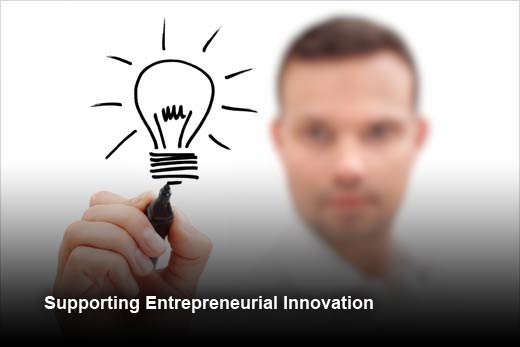Businesses fail. Research indicates that over 50 percent of new firms fail within five years, and 75 percent are gone within 10 years after that. So what is different about the firms that survive? They are successful in recreating themselves, in continuing to engage entrepreneurial thinking on an equal footing with strategy. In other words, they bust the chains of staid thinking. They encourage their people to find ideas that can lead to new opportunities.
So where do great ideas come from? Many believe that there are only certain creative people and then there are the rest of us. Nonsense. There are certainly some people who are more creative than the norm, but if we want firms to develop and exploit entrepreneurial opportunities, the first step is recognizing that opportunities come from everyday people.
To foster this kind of entrepreneurial thinking, the key is to establish a corporate culture that accepts failure and rewards effort and experimentation, so that everyone within the organization is comfortable applying an entrepreneurial mindset to their work.
It takes time and discipline to change a corporate culture, and while there is no magic formula for success, there are a few key markers that must occur along the journey. In this slideshow, Jim Dewald, author of Achieving Longevity: How Great Firms Prosper Through Entrepreneurial Thinking, identifies some of the proven systems and processes management can implement to support entrepreneurial thinking and innovation.
Jim Dewald is the author of Achieving Longevity: How Great Firms Prosper Through Entrepreneurial Thinking. He is the dean of the University of Calgary’s Haskayne School of Business and an associate professor in strategy and entrepreneurship. Prior to entering academe, he was active in the Calgary business community as the CEO of two major real estate development companies and a leading local engineering consulting practice, and president of a tech-based international real estate brokerage company.
Supporting Entrepreneurial Innovation
Click through for proven systems and processes that management can implement to support entrepreneurial thinking and innovation, as identified by author Jim Dewald.
Create an Open Environment
Establish a clear narrative of entrepreneurial success within the firm.
This demands a highly egalitarian and transparent organization in which employees feel comfortable asking the boss questions. It should be completely plausible that any team member with the necessary skills and abilities can rise to the top.
Focus on Creation
Entrepreneurial organizations require risk taking and bold initiatives, which demands an environment characterized by equality, security, and lack of control.
When Michael Sikorsky, the engaging CEO of Robots & Pencils, is faced with an employee breaking a rule, he is more likely to challenge “why do we have a rule” than concern himself with the employee’s behavior. The point is to be respectful of one another and focused on creating new apps, not following a bunch of rules.
Bricolage
Identify the idea generation path most suited to the organization.
One such path is “bricolage” – best described as “making do with what one has” to meet a customer need. Picture the movie Apollo 13 when the NASA lead throws a bunch of spaceship parts on a table and tells the team, “Build an air exchanger.” Bricolage represents unknown means, but known predetermined outcomes. Possibly the most recognizable bricoleur was the TV character MacGyver, who regularly demonstrated that anything is possible with a stick of chewing gum, wire and a wrist watch.
Effectuation
Another path for idea generation is “effectuation” in which entrepreneurship is driven by discoveries within the firm.
Effectuation is a process of known means of discovery with unknown outcomes. The approach at Honda is to first start with pushing the bounds of propulsion. Decades ago, Honda began work on ASIMO, a pioneering initiative in robotics that had no specific commercial outcome, but was fascinating science.
Discovery
Engage in an opportunity discovery and creation process.
Discovering opportunities can be a highly planned and purposeful corporate action. It is a matter of prioritizing, setting aside the always present tasks of the day, pulling together an interdisciplinary team, and giving them the encouragement and freedom to explore ways to do things differently.
Some opportunities are gaps in the marketplace waiting to be discovered. Clayton Christensen tells the story of a quick service restaurant that faced an unexpected explosion of milkshake sales in the early morning hours. Brought in as a consultant to investigate, Christensen determined that the milkshake was being used as a substitute for coffee during early morning commutes. The milkshake was cold to hold onto, kept people awake, and lasted for twenty to thirty minutes (the typical length of the drive). A sales opportunity had been discovered, somewhat by accident.
Other opportunities are created seemingly from thin air. Opportunity creation ties more closely to the process of effectuation, such as inventing and developing Honda’s robotic capabilities to create opportunities for use of their robotic technology in medical operating rooms.
Support Middle Management
Middle management plays an important role in balancing the tensions between front-line workers who take individual initiative and organizational needs for guidance and control.
Middle management action is where the rubber meets the road and entrepreneurial thinking is enacted to change an organization and its prospects for longevity. This can be true even in the public sector. In the example of Central Memorial High School’s conversion to a performing arts school, the support of board trustees and superintendents was important, but the courageous actions of the principal and department head made the entrepreneurial idea a strategy and an action that transformed the school.









